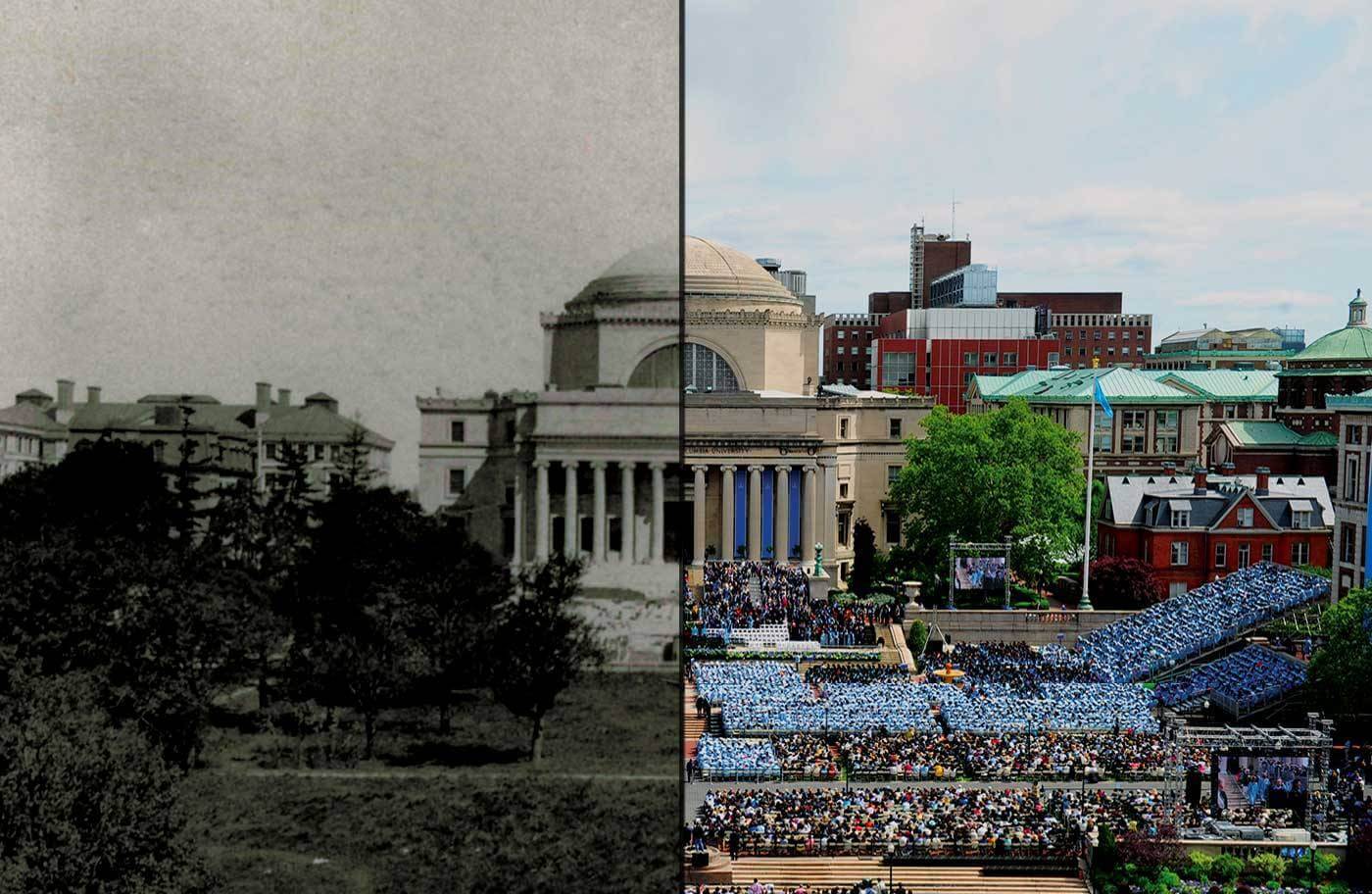Commencement History & Regalia

Left image: 1897, Right image: 2015
Seven men were graduated with the degree of Bachelor of Arts, and four honorary degrees were conferred. The exercises were conducted almost entirely in Latin during the King’s College period, and for yet another century, classical orations formed a regular part of the program.
During the pre-Revolutionary period, the Commencement procession passed through the city streets from the College building on Park Place to Trinity Church or one of its chapels. When King’s College became Columbia, in 1784, Commencement was held in various churches and halls. After the College moved to Forty-Ninth Street and Madison Avenue in 1857, Commencement usually took place at the Academy of Music at Fourteenth Street and Irving Place. Since 1898 Commencement has been held on the campus at Morningside—at first in the University gymnasium, and since 1926 outdoors on Low Plaza.
The modern academic costume originated in the Middle Ages when a warm gown and hood were useful for scholars and clerics in unheated buildings. The distinctive gown served to set the student apart from his fellow citizens, hence the perennial controversy between “Town and Gown.” Until after the American Civil War, Columbia students wore caps and gowns daily while in residence.
In 1894, an American Intercollegiate Commission met at Columbia for the purpose of standardizing the style and color of robes and hoods. At that time it was decided that all robes would be black; bachelors’ gowns to be made of worsted stuff with pointed sleeves; masters’ gowns of silk with long closed sleeves; doctors’ gowns faced with black velvet with three bars across the sleeves. Hoods were made of the same materials as the gowns, the length varying with the degree. Only the lining of the hood indicated the university—for Columbia, light blue with a white chevron. The border color indicated the academic discipline in which the degree was earned.
The Columbia gown is light blue. The doctoral gown has a facing of black velvet, with three black velvet chevrons on each sleeve. Columbia crowns are embroidered at chest height. People with earned doctoral degrees wear a hood with the color of the velvet trim representing the degree earned. In the case of Ph.D., the dark blue color is used to represent mastery and scholarship in any field that is attested to by the awarding of this degree and is not intended to represent the field of philosophy. Doctoral degree holders wear an eight-cornered velvet tam with a gold tassel.
Masters’ and bachelors’ gowns have the Columbia crown embroidered on black tabs at chest height. Hoods are not used for graduates at Columbia University. A four-cornered light blue mortarboard with a black tassel is worn. Masters’ robes are differentiated from bachelors’ robes by an oblong sleeve open at the wrist. Teachers College and Barnard College follow Columbia University traditions.
The interior of the hood displays the University colors as in the past, and the facing and backing of the hood are in the standard degree colors:
- Brown: architecture and the fine arts
- White: arts and letters
- Light brown: business
- Lilac: dentistry
- Light blue: education
- Orange: engineering
- Peacock blue: international and public affairs
- Cardinal: journalism
- Purple: law
- Lemon yellow: library service
- Green: medicine
- Pink: music
- Apricot: nursing
- Olive: pharmacy
- Dark blue: philosophy
- Teal: physical therapy
- Salmon pink: public health
- Golden yellow: science
- Citron yellow: social work
- Scarlet: theology
The eighteenth-century mace carried in the Columbia ceremonies was given to the University by the late Judge John Munro Woolsey, LL.B. 1901, LL.D. 1929. It is of Sheffield plate, topped with a king’s crown over a design of acanthus leaves. The mace was the symbol of authority in British courts.
